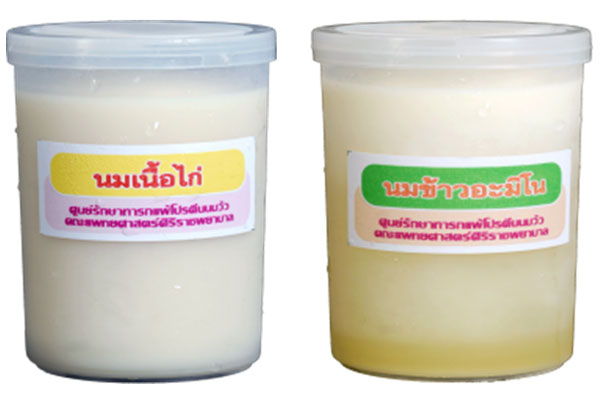Faculty of Medicine Siriraj Hospital

Mosquito Transmitted Viruses: Investigating Basic Mechanisms to Develop Therapeutics
October 24, 2019
High Volume – Sensitive qPCR (Ultra – Sensitive qPCR, Molecular Techniques for the Detection of Low – Density Malaria Parasitemias)
October 24, 2019Innovations in Chicken – based formula and Ricamino formula for Management of Cow’s Milk Protein Allergy

Faculty of Medicine Siriraj Hospital, Mahidol University
There are approximately 20,000 Thai infants and young children up to 2 years of age who are allergic to cow’s milk protein each year. In order to avoid allergic symptoms, they may need the imported commercial amino acid-based formulas for one year or longer. Such formulas are very expensive; this is economically problematic for their parents. Two modular formulas, made from chicken and amino acids with rice glucose polymer, were invented and called chicken-based formula and ricamino formula, respectively. Both innovated, less expensive formulas have been used to effectively treat more than 2,000 Thai children with cow’s milk protein allergy for 20 years. Additionally, if these formulas are commercially exported, they can bring about an economic benefit for Thailand in the long run.
Project : The chicken-based formula is made from chicken breast with a unique technique of homogenizing chicken flesh into very small particles, and is added with vegetable oils, rice glucose polymer, vitamins, and minerals, so that it contains appropriate nutrients for infant’s growth. Infants with cow’s milk protein allergy can tolerate the chicken-based formula very well, as clinically tested and reported in the medical journals. (Jirapinyo P, et al. Asia Pac J Clin Nutr. 2007;16(4):711-5), (Jirapinyo P, et al. Asia Pac J Clin Nutr. 2012;21(2):209-14)
However, some infants with cow’s milk protein allergy are still allergic to either the chicken-based formula or imported commercial amino acid-based formulas. This fact leads to a new idea of inventing glucose polymer from rice powder. The process starts with a 2-hour digestion of rice powder with amylase enzyme under an optimal temperature, and a removal of protein and other residuals. The resulting rice glucose polymers are in tiny molecules with less protein content. The ricamino formula is composed of all 20 amino acids, vegetable oils, rice glucose polymer, vitamins, and minerals, which are mixed together in liquid form; it is then kept frozen until being used. The ricamino formula contains complete nutrients and is well tolerated by infants with cow’s milk protein allergy. (Jirapinyo P, et al. Nutr Clin Pract. 2016;31:824-8), (Jirapinyo P, et al. Asia Pac J Clin Nutr. 2017;26(5):in press)
The Expected Results : Parents usually do not recognize that their child is allergic to cow’s milk protein, so the child is treated only symptomatically. When the child grows up, symptoms of cow’s milk protein may disappear without specific treatment but he/she may be at risk of developing other allergic diseases later in life. Even some breast-fed infants may have severe allergic symptoms in spite of maternal allergenic food avoidance. Current standard treatment of cow’s milk protein allergy suggests that a child switch to a hypoallergenic formula, which is somewhat expensive. If Thai infants and young children who are allergic to cow’s milk protein allergy need to use commercially available imported hypoallergenic formulas, including extensively hydrolyzed protein formula and amino acid-based formula, this will cost us a yearly expense of 1,000 million Baht. In conclusion, the chicken-based formula and the ricamino formula have been creatively invented in order to solve the problems of both cow’s milk protein allergy and the cost of its treatment.
We look forward to developing powder form of both formulas at a large scale, manufacturing level and applying for license from the Thai Food and Drug Administration Ministry of Public Health.

Prof. Pipop Jirapinyo
Faculty of Medicine Siriraj Hospital, Mahidol University
